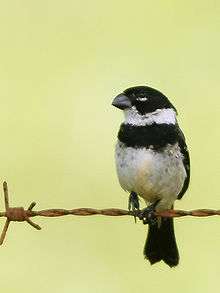Morelet's seedeater
Morelet's seedeater (Sporophila morelleti) is a passerine bird in the typical seedeater genus Sporophila.
| Morelet's seedeater | |
|---|---|
 | |
| Scientific classification | |
| Kingdom: | Animalia |
| Phylum: | Chordata |
| Class: | Aves |
| Order: | Passeriformes |
| Family: | Thraupidae |
| Genus: | Sporophila |
| Species: | S. morelleti |
| Binomial name | |
| Sporophila morelleti (Bonaparte, 1850) | |
Taxonomy
This species has been split into two species of the paraphyletic white-collared seedeater, which are not known to intergrade. The S. (t.) torqueola group, comprising the subspecies torqueola and atriceps and commonly known as the cinnamon-rumped seedeater, is found from Sinaloa and Durango to western and southern Oaxaca. S. morelleti group, comprising the subspecies morelleti, sharpei, and mutanda and commonly known as Morelet's seedeater, is found throughout the rest of the species' range.[2]
Distribution and habitat
It ranges from a small area along the Rio Grande near San Ignacio, Texas in the United States[3] south through eastern Mexico and Central America to Panama. It mainly inhabits tropical and subtropical grasslands, savannas, and shrublands but can also be found in pastures, arable land, and heavily degraded former forests.[1]
Foraging
The Morelet's seedeater eats mainly seeds and insects, and occasionally berries. It often forages on herbaceous plants, and less often on the ground. In captivity, it drinks and bathes often, but in the wild no drinking was observed, even though more than 300 hours of field notes were taken.[4]
References
- BirdLife International. 2017. Sporophila morelleti (amended version of 2016 assessment). The IUCN Red List of Threatened Species 2017: e.T22731776A119483309. https://dx.doi.org/10.2305/IUCN.UK.2017-3.RLTS.T22731776A119483309.en. Downloaded on 29 June 2018.
- Rising, J. (2011). del Hoyo, J.; Elliott, A.; Sargatal, J.; Christie, D.A.; de Juana, E. (eds.). "White-collared Seedeater (Sporophila torqueola)". Handbook of the Birds of the World Alive. Barcelona: Lynx Edicions (published 2014). Retrieved 19 July 2015.
- "White-collared Seedeater". Bird Info. World Birding Center. Retrieved 2009-01-06.
- "White-Collared Seedeater". Birds of North America. Cornell Lab of Ornithology. Retrieved 7 April 2017.
Further reading
Book
- Eitniear, J. C. 1997. White-collared Seedeater (Sporophila torqueola). In The Birds of North America, No. 278 (A. Poole and F. Gill, eds.). The Academy of Natural Sciences, Philadelphia, PA, and The American Ornithologists’ Union, Washington, D.C.
Articles
- Azpiroz AB. (2003). First records of the White-collared Seedeater (Sporophila zelichi) for Uruguay. Ornitologia Neotropical. vol 14, no 1. p. 117-119.
- Bencke GA. (2004). The seedeater Sporophila zelichi observed in Rio Grande do Sul, Brazil. Ararajuba. vol 12, no 2. p. 170-171.
- Eitniear JC. (1997). White collared seedeater: Sporophila torqueola. Birds of North America. vol 0, no 278. p. 1-12.
- Eitniear JC. (2004). Diet of the white-collared seedeater Sporophila torqueola (Passeriformes: Emberizidae) in Texas. Texas Journal of Science. vol 56, no 1. p. 77-81.
- Woodin MC, Skoruppa MK, Blacklock GW & Hickman GC. (1999). Discovery of a second population of white-collared seedeaters, Sporophila torqueola (Passeriformes: Emberizidae) along the Rio Grande of Texas. Southwestern Naturalist. vol 44, no 4. p. 535-538.
